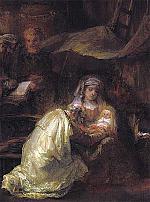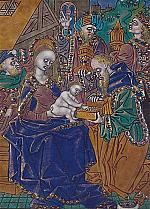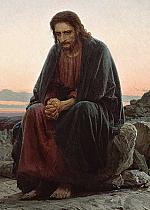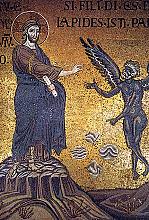Celebrating Christ’s birth
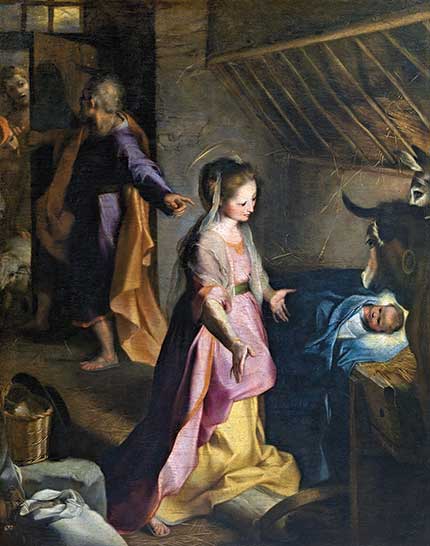
[ABOVE Federico Barocci, Nativity, 1597. Oil on canvas—Prado Museum / Public domain, Wikimedia]
From Advent we move through the year to Christmas—both the day and the season. We’ll look first at the day.
Where did it come from?
By now you know that the Advent and Christmas seasons developed backward from the celebration of Epiphany. The first reference to Christians celebrating Christ’s birth on December 25, rather than January 6, is in the mid-fourth century. Then in a sermon in 386 John Chrysostom (347–407) referred to Christ’s Nativity as a feast that “has now been brought to us, not many years ago” and “has developed so quickly and borne such fruit.”
The name “Christmas” is a shortening of “Christ’s Mass” in Middle English; the history of names for the feast in different languages is complex, but one common earlier name in Latin was the Feast of the Nativity. Many liturgical churches still call the church service on the day itself the Feast of the Nativity to distinguish it from secular/cultural Christmas celebrations.
But why this date, given that no one knows when during the year Jesus was actually born? Sextus Julius Africanus (160–240), an early third-century Christian historian, is among the first to refer to Jesus’s conception on March 25 and thus, by simple math, his birth nine months later on December 25. (Why March 25? We’ll talk about this again when we get to Holy Week, but many Christian thinkers believed Jesus was conceived on March 25 and died that same day.)
About 30 years after Africanus died, the Roman Empire began celebrating a day in the 270s dedicated to the rebirth of the Unconquered Sun (Sol) on December 25. This new feast came directly after a festival of gift-giving called Saturnalia, which began on December 17 on the Roman calendar; members of the Roman military also celebrated the birthday of the god Mithra on the 25th. It seems likely that some Christian believers were motivated to celebrate the feast of the true God rather than Sol or Mithra on December 25 instead. Christmas Eve, just like other “eve” feasts, grew out of the custom Christians inherited from Jewish practice of beginning the day at sundown (see pp. 2–3).
How is the date determined?
Christmas is celebrated on December 25 in most of both Eastern and Western Christianity, but since some Eastern churches use the Julian calendar, their celebration takes place on what the modern Gregorian calendar considers to be January 7.
Theological themes
The major themes of Christmas Eve and Day are, of course, all aspects of the Nativity of Christ. This includes the story of his birth as given in Scripture, especially its humble nature; the miracle of God becoming incarnate as man; and the wonder of Christ being both human and divine. Special emphasis in the Nativity story is often given to Mary’s willingness to bear the Son of God (Eastern churches commonly call her Theotokos, or Mother of God, which highlights this). Sermons and customs also speak frequently of Joseph’s role as Jesus’s earthly father and protector, and the fact that Jesus’s birth was first revealed to humble shepherds and not to the powerful.
Colors
Western liturgical churches usually use white and gold on Christmas Day and during Christmastide (see pp. 14–15). Churches of all types, liturgical and not, usually decorate sanctuaries with greenery. Red and green, the colors most often associated in modern culture with Christmas, also play a part in decorations. (Red and green were associated with Christmas historically in the West because they are the colors of holly, but they became solidified as the cultural Christmas colors through a set of Coca-Cola advertisements in 1931—true story!) Gold is the main color in the Eastern church; white is sometimes used on Christmas Day only.
Customs
It is difficult to disentangle “cultural Christmas” from “liturgical Christmas,” even among devout Christians. The battle between Christmas as a largely secular, and often rowdy, celebration with family and friends versus Christmas as the marking of the Incarnation through song and story has been a centuries-old problem, and one that people still complain of today.
Most famously the Puritan movement banned Christmas in the seventeenth century both in England and in the North American colonies, calling celebrations marking the occasion—which included drinking, dancing, and breaking down all kinds of social norms—unscriptural and deeply pagan. Colonial Puritan preacher Increase Mather (1639–1723) once wrote that early Christians did not keep December 25 as a feast because “Christ was born in that month, but because the heathens’ Saturnalia was at that time kept in Rome, and they were willing to have those pagan holidays metamorphosed into Christian [holidays].” While celebrations of Christmas eventually returned after a restored English monarchy replaced the Puritan movement, Mather speaks for many even today who reject the cultural trappings of Christmas and sometimes do not celebrate the holiday altogether.
Some church-related ceremonies honoring the Nativity include the hanging of greenery; the lighting of a white “Christ candle” in the middle of an Advent wreath; the performance of nativity pageants, a tradition that reaches back into the Middle Ages; services of lessons and carols telling the story of salvation history (a custom dating to the late nineteenth century and most closely associated today with King’s College, Cambridge); the singing of songs celebrating the birth of Christ after these have been forbidden during Advent; and the placing of a creche (nativity scene) in the sanctuary or placing baby Jesus into an already-present creche. In lower church settings, some or all of these things may occur during Advent instead. Even among churches that don’t celebrate the Eucharist frequently, many do so on Christmas Eve (often at 11:00 p.m. so as to end at midnight). More liturgical churches will offer the Eucharist on Christmas Day as well.
Christmas trees frequently form part of sanctuary decorations today. Originally evergreen boughs were used as pagan symbols of the Roman and Norse gods, but Christians began to use trees to depict biblical truth in the Middle Ages. This arose out of the custom of “paradise trees” in nativity plays to represent the Garden of Eden.
After the Reformation and the suppression of outdoor pageants, these trees moved inside people’s houses, and this custom became especially popular among Protestants in Northern Europe. Eventually candles and gifts were hung on these trees; while the idea of doing so is popularly credited to Martin Luther, no solid evidence supports this. Today trees in churches are often decorated with “Chrismons,” gold and white Christian symbols. The word stands for “Christian monograms,” and the custom originated among mid-twentieth-century Lutherans.
Gift-giving flourishes widely among those who have never celebrated Christmas in a church setting, but it is tied most closely to Christian traditions around Christmas through the figure of St. Nicholas (although his feast day, December 6, is actually in Advent). Nicholas was bishop of Myra in the fourth century; most of what is known about him is legendary, including his (plausible) attendance at the Council of Nicaea and (less plausible) punching of the heretic Arius in the face at the council. Nicholas was alleged to be particularly charitable to the poor, and stories tell of him giving dowries to poor girls who otherwise would not have been able to marry and might have had to resort to prostitution.
The custom of giving gifts on his feast day arose in the Middle Ages; his contemporary evolution into Santa Claus happened much later through traditions Dutch immigrants brought to North America. The modern idea of a fat, jolly Santa giving presents on Christmas Eve crystallized, at least in the American imagination, through the 1823 poem called “A Visit from St. Nicholas” by Clement Clarke Moore (1779–1863) and the 1862 drawing of a round and happy St. Nick by cartoonist Thomas Nast (1840–1902). CH
Some things you can do at home
• Alongside any preexisting home-based traditions, consider attending church on Christmas Day, celebrate the Feast of St. Nicholas on December 6, and choose an element of “cultural Christmas” to forego.
• Incorporate an Advent wreath into your home worship, and light the Christ candle on Christmas Day.
By Jennifer Woodruff Tait
[Christian History originally published this article in Christian History Issue #156+ in 2025]
Jennifer Woodruff Tait is Senior Editor of CH magazineNext articles
Twelve days of Christmas
Prolonged celebrations are supposed to start on Christmas day.
Jennifer Woodruff TaitAsh Wednesday
Believers are commanded to observe the beginning of Lent with repentance and prayer.
Jennifer Woodruff TaitForty days in the desert
Lent is a time of preparation for the celebration of Jesus’s Resurrection and the Easter feast.
Jennifer Woodruff TaitSupport us
Christian History Institute (CHI) is a non-profit Pennsylvania corporation founded in 1982. Your donations support the continuation of this ministry
Donate



